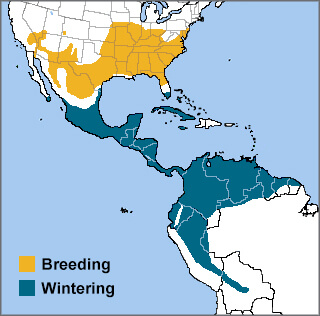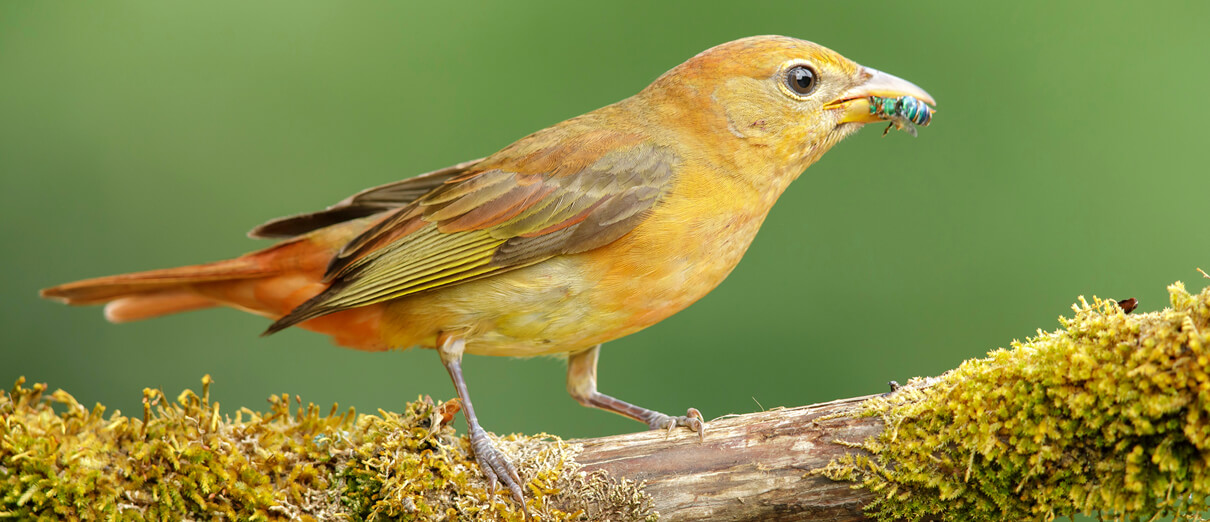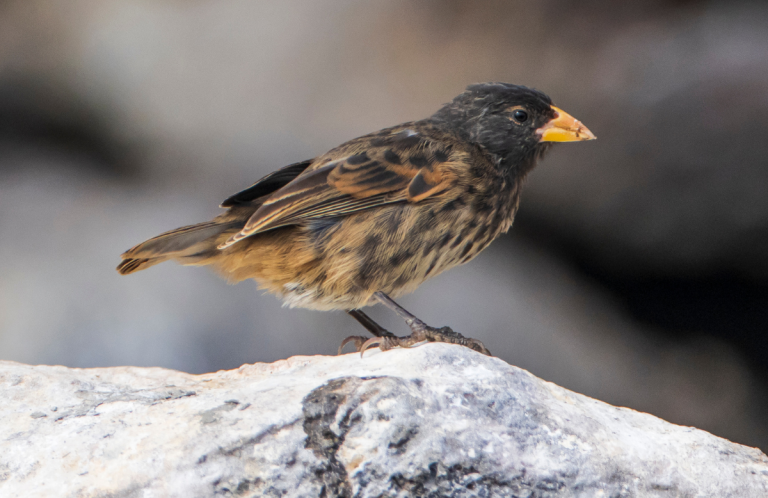
Summer Tanager range map by ABC
The rose-red male Summer Tanager is the only completely red bird in North America — the male Northern Cardinal has a black mask; the closely related Scarlet Tanager has black wings and tail; and the duller-red Hepatic Tanager has grayish flanks and cheek patches. The female Summer Tanager is a warm orangish-yellow, and first-spring males have an interesting intermediate plumage patched with yellow and red.
This chunky, thick-billed songbird is surprisingly difficult to spot in the treetops, but it can be easily detected by its burry song and chuckling call notes.
Bee Bird
The Summer Tanager's stout, pointed bill allows it to easily capture and neutralize its preferred prey, bees and wasps and their larvae. Its predilection for stinging insects earned this songbird the nickname "Bee Bird." When foraging, the Summer Tanager darts out from a perch to snatch a bee or wasp in mid-air, then subdues the insect by beating it against a branch. Before eating its catch, the tanager first removes the stinger. Summer Tanagers also rip into wasp nests to eat the larvae inside.
Many beekeepers consider the Summer Tanager a pest, but it rarely takes enough insects to pose a significant threat to a hive.
Northeast by Southwest
The Summer Tanager breeds across much of the eastern and southwestern United States and northern Mexico. Eastern and southern populations prefer open oak, hickory, and mixed oak-pine woodlands, and western populations breed in riparian woodlands of cottonwood and willow.
Like the closely related Western Tanager, the Summer Tanager is a long-distance migrant, moving south to winter from central Mexico into South America, as far south as Bolivia and Brazil. It migrates during the night, with eastern populations making the long flight directly across the Gulf of Mexico.
On its wintering grounds, the Summer Tanager also favors open woodlands, but can also be found in second-growth forest and edge, on plantations, and even in urban parks and gardens.
There are two widespread Summer Tanager subspecies. The western group is duller and paler-plumaged than the brighter-red eastern subspecies. A third subspecies is only found in northwestern Arizona.
The Summer Tanager's distinctive call is a staccato “picky-tuck-tuck.” Its song is similar to that of the American Robin, but slower and more variable.
Listen here, first to the call, then the song:
(Audio: Jim Holmes, XC333286. Accessible at www.xeno-canto.org/333286 · John A. Middleton Jr., XC643125. Accessible at www.xeno-canto.org/643125)
Feeding on the Fly
Although Summer Tanagers specialize in hunting bees and wasps, they also take a wide variety of other invertebrates, such as beetles, dragonflies, cicadas, grasshoppers, caterpillars, and spiders. While foraging, Summer Tanagers stay in the mid- to upper levels of the forest canopy, often repeatedly sallying out from the same perch like a flycatcher.
This versatile tanager also feeds on small fruits and berries, particularly on its wintering grounds. It may also visit backyard feeders for jam and suet.
Dueling Tanagers
Male Summer Tanagers arrive on the breeding grounds first, then stake out a territory that they defend against other males through singing duels and frequent chases. They continue to defend their nest site and a feeding territory throughout the breeding season. After females arrive on the breeding grounds, males court them with more singing, calling, and chasing.

Female Summer Tanager with insect. Photo by Agami Photo Agency, Shutterstock
After mating, the female builds a cup-shaped nest of stems, leaves, and grasses high up and well out on a horizontal branch, often over a clearing or stream. There, she lays two to four eggs. The male feeds the female as she incubates, and both parents feed the hatchlings as they mature. A Summer Tanager pair usually raises only one brood per season.
Summer Tanagers seem to recognize the threat posed by brood parasites such as Brown-headed Cowbirds, chasing them away from their territories whenever possible. Nevertheless, their nests are often parasitized.
Keeping the Bee Bird Buzzing
Although Summer Tanager populations are currently considered stable, the species is still vulnerable to habitat loss, particularly the clearing of riparian habitat in the western United States. There, the Summer Tanager shares habitat with several threatened birds, including the Southwestern Willow Flycatcher and western race of the Yellow-billed Cuckoo.
ABC works to preserve riparian habitat throughout the Southwest. We have advocated for the San Pedro River, one of the last major undammed rivers in the American Southwest. The San Pedro Riparian National Conservation Area, which protects important habitat for the Summer Tanager and many other species, including the Elf Owl and Costa's Hummingbird, was the first site designated by ABC as a Global Important Bird Area.
Migrating Summer Tanagers are vulnerable to collisions with communications towers and other human-built obstacles along their journeys. ABC offers a variety of solutions to this problem, both for interested birders and businesses.
Donate to support ABC's conservation mission!



















































